Fungi, Moulds and Yeasts
Fungi are plants that do not contain chlorophyll. They often cause diseases in the bodies of the living things they enter, generally by causing infections. At the same time they meet a large part of the food and mineral needs of living things on Earth and are essential to the survival of life on the planet. Around 90,000 different species have been described.
 |
It is He Who sends down water from the sky. From it you drink and from it come the shrubs among which you graze your herds. (Surat an-Nahl, 10) |
According to some estimates, there are 1.5 million known and unknown different species of fungi. 82
Fungi generally multiply in the dark, in moist environments and everywhere there is organic matter. They prefer warm environments. Even though they do not multiply readily in the cold, it is still impossible to kill them by freezing. At cold temperatures, they enter a kind of hibernation and wait for warmer temperatures to come.83 Of the 55 species of fungus found in the human body, almost 30 cause diseases. The others are harmless. 84
Fungi also take the form of moulds and yeasts, depending on the functions they perform and their characteristics. Yeasts used in the fermentation process, and the moulds used in the manufacture of drugs and food, are actually nothing more than different species of the fungi that can cause sickness and death in plants and animals. Fungi predominate over a large part of the Earth. Elaine Ingham of Oregon State University has calculated that when all the fungus mycelia in just one teaspoonful of forest soil are laid end to end, they can stretch for 1.5 miles (2.4 kilometers), and that they will weigh 4,000 times more than all the bacteria in that same soil specimen. The fungi in a teaspoonful of soil from humid forests at sea level will stretch for 65, or even 650 kilometers (40 to 400 miles).85 This high level of incidence of fungi on Earth is of the greatest importance to maintaining life. Let us consider this subject under another heading.
Fungi Are Essential To The Continuation Of Life On Earth
Fungi have one essential feature: They break substances down, reducing complex organic substances into simple organic compounds and inorganic molecules. They break up nutrients that other living things cannot ingest into simple compounds that they can. In doing so, the obtain their own vital energy. Unlike other living things, fungi do not digest food after eating it. They digest, or dissolve it first, and then eat it. They release a special enzyme to break down the substance they are going to eat into its separate compounds. By this method they are able to break down organic matter around them. Fungi consist of, thin fibers divided into branches known as mycelia, whose cells expand at great speed for food digestion.
This can be viewed more clearly under a microscope. These protracting arms release enzymes that can break down and digest almost anything organic, even solid substances. The dimensions of the micro-fibers are just 1/100.000 inch, (almost 2.54 centimeters) and a new branches form every half hour. This growth is so rapid rate that the total length of the cells emerging from a single fungal spore multiplying at that speed over two days can reach hundreds of kilometers. 86
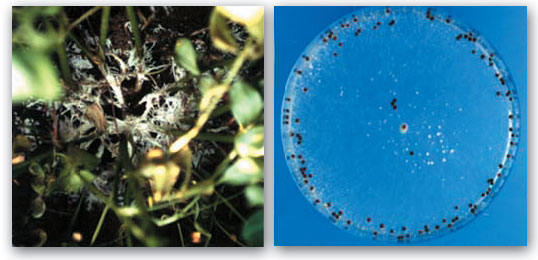 |
Fungi can easily break down everything around them. That is because their bodies consist of microscopic branches known as mycelia. |
These arms permit the fungi to reach a wide variety of places. These arms and the enzymes make fungi one of the most fundamental living things, apart from bacteria, that turn organic and inorganic substances into simpler molecules. This transformation is vitally important because some living things lack the ability to absorb complex organic substances into their bodies, and first need them to be separated into simpler components. Fungi turn these complex substances into simple organic ones for other living things to make use of.
The enzyme secreted by the fungus turns that source of food substance into smaller molecules. The fungus absorbs its nutrients into itself, but, thanks to the remaining enzyme broken-down organic substances remain. Fungi permit important elements like carbon, nitrogen and phosphorus to be released and made ready for use by other organisms. As this breakdown occurs, carbon dioxide necessary for photosynthesis is released into the atmosphere and important minerals return to the soil. This breaking down process is very wide-ranging. Fungi can break down dead plants, dead animals, dyes, shoes, plastics, paper, clothing and even petrolium. 87
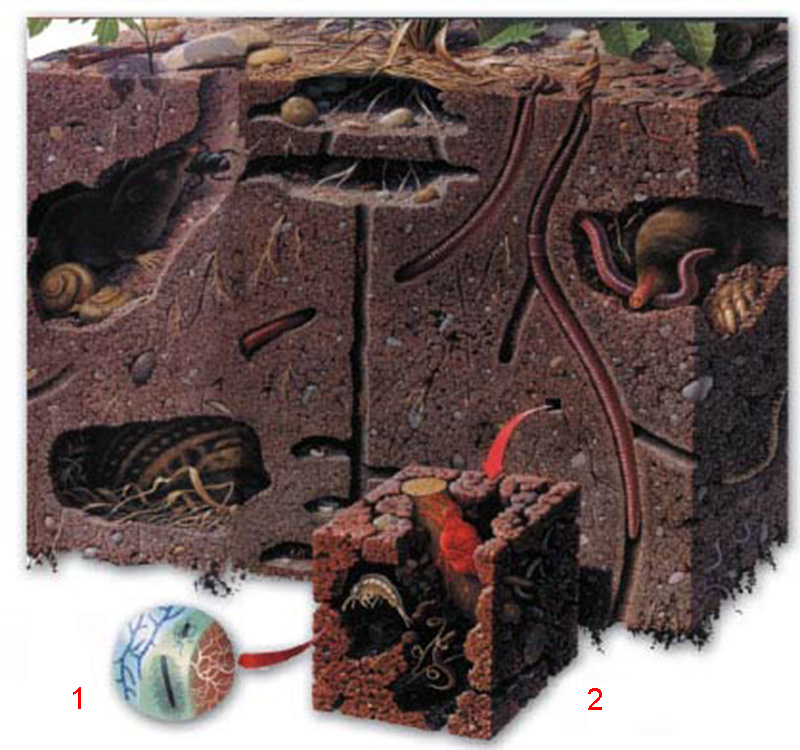 |
1. Bacteria and fungi, |
Fungi, together with other microorganisms, actively turn underground food sources into cell materials. |
What would happen if this process did not take place? All the basic nutrients for the continuation of life would remain locked up inside dead animals and plants. These nutrients could not be released and returned to the ecosystem. Since one of life's essential recyclings failed to take place, life on Earth would soon come to an end.88 Therefore, fungi are indispensable. Their only aim may be to secure their own nourishment, and they are likely unaware of the power of the enzyme they secrete in becoming the source of building blocks for all living things.
Fungi sometimes inhabit fertilizers and manure and carry out the breaking down process in these. This process is of great importance. Fungi begin the breaking down process in the fertilizer and consume cellulose. As soon as most of the cellulose has been consumed, the breaking down process is then taken over by bacteria.89 This is the secret behind the usefulness to plants of fertilizers in the soil.
The fungus is also literally expert in turning foodstuffs into new cellular materials. If an excessive amount of foodstuffs needs to be digested, it conceals them in its own body in a large number of cells. Thus it not only stores for itself the food it possesses, it also expands its body to produces new deposits. Even if it has no immediate need for nutrients, it knows that it needs to store them in a manner inspired by Allah.
Fungi's Symbiotic Relationship With Plants
Fungi and plants enjoy a mutual assistance, and the fungus that enables this goes by the name of Mycorrhizae. More than 90% of the world's plants have such a relationship with fungi. Some plants grow stronger and are invigorated with the help of fungi, while others' survival depends on them entirely.
The breaking down performed by fungus in the soil provides minerals to nourish plants, which develop quickly and become stronger than before. At the same time, the plant feeds this fungus by providing it with sugar, amino acids and other important organic substances. For example, orchids that fail to enter into such a partnership life with fungi soon die and many forest trees gradually come to the drying stage. When fungi and fungus spores are applied to them, they revert to normal growth.90 To put it another way, fungi are essential to the life of plants, one of the most important components of life.
 | |
1. External tendrils, | 6. Orchid endomycorrhizae, |
The structure of the fungus Mycorrhizae that enters into a symbiotic relationship with plants. | |
The Mycorrhizae that enter the tree roots and supply them with food also help the roots cling to rocky places. Furthermore, this fungus protects the pine trees' roots from various diseases. The only thing this talented fungus, which fixes the tree in position, protects it from various diseases and extracts and releases phosphorus, other nutrients in the soil and water to share with the plant, receives in return is a quantity of sugar. 91
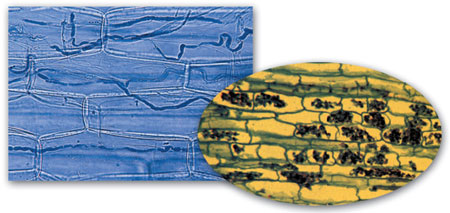 |
Fungi that have surrounded plant roots and provide food for plants. |
In this simple example, the illogicality of the false mechanisms of evolution are plain to see. According to evolution, each living thing should be engaged in an individual struggle for survival, but here, they actually strive to keep one another alive. Moreover, the way that a plant possessing photosynthesis, seeds, and leaves that are a major source of oxygen stands in need of fungal cells too small to be seen with the naked eye, is another serious question for Darwinists. Despite structural perfection in all regards, plants still depend on other tiny living things. Their very special and complex systems are unable to extract food from the soil by themselves. How can it be that this property does not occur in these superior species, but manages to occur in a microorganism?
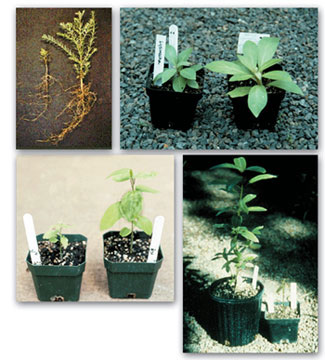 |
The living and healthy plants seen in the picture are those which share a common life with fungi. Those plants with no mycorhizzae in their roots, on the other hand, are weak and undeveloped. |
As with the thousands of similar questions, Darwinists are in a state of grave doubt when it comes to answering this one. They propose an inconsistent process of evolution that never actually happened. Coming up with stories for such a fictitious process is hardly scientific. If microorganisms invisible to the naked eye accomplish what giant trees and different varieties of plant cannot, that exhibits the incomparable and superior intellect of Allah, Who created them.
Allah has revealed in the Qur'an:
That is Allah, your Lord. There is no god but Him, the Creator of everything. So worship Him. He is responsible for everything. (Surat al-An‘am, 102)
Fungi Cause Various Diseases
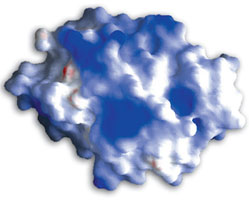 |
Cutinase enzyme |
In addition to assisting in plants' growth and development, fungi can sometimes be invaders with lethal properties. A fungus can stealthily takes its place in the body of another organism and quietly take over. If this living thing is a plant, all its cells will soon become food for the fungus.
When it reaches a leaf, the fungus secretes an enzyme known as cutinase which dissolves the waxy layer covering leaves and stems. Following this, the fungus's main obstacle has been overcome and it can easily spread through the plant.92 But how can the fungus produce a special enzyme to overcome the waxy layer? In fact, this microscopic organism has been created together with a number of important properties that let it resolve this difficulty: an enzyme with has just the right properties to dissolve that waxy layer—neither too weak to dissolve that layer, or so powerful as to destroy the leaf entirely. Yet the microscopic secretion from this microscopic organism carries out its duty to the letter. Following this process, the fungus will behave in the manner inspired in it and begins to interpenetrate the plant to break it down as a source of food.
Another example is the species of fungus that takes over the branches of a pine tree. Once a fungal spore has settled on a damp pine needle, it germinates, enters the needle through one of its pores and deposits its germ tube inside. After the fungus has entered the needle's vascular system, it begins spreading towards the branch. Fungal filaments spread out in along the branch, penetrating everywhere they reach. As a result, the fungus eventually encircles the branch like a cuff, cutting off its flow of nourishment.93 Unable to receive sap, the branch soon dies.
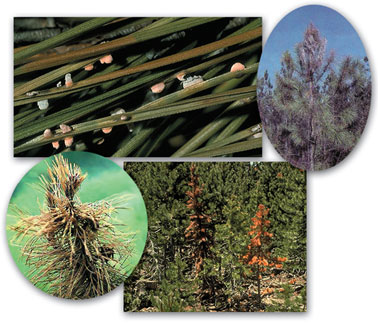 |
A fungus settling on a moist pine needle spouts and deposits a microbe tube from its pores. Shortly afterwards the entire branch dies and becomes food for the fungus. |
In a forest there will be between 100 and 200 fungi species living in and around plants and trees. Some of these are active in the tree trunks or branches where they settle. The great majority of these are opportunists waiting to devour a tree when it is stressed or its limbs begin dying. There also fungi those wait underground, awaiting their opportunity. The canopy fungi wait patiently for a tree's branch to rot and fall to the ground.
Some fungi begin their activities while the tree is still alive. Trees are generally faced with some 15 fungus species that cause disease, but are not serious enough to kill the tree. They tend to cause diseases that are visible to the eye but that then pass away, rather like colds in humans. Some of these may, have permanent effects, however. For example, the diseases spread by these fungi may prevent the tree species growing a region from reproducing and thus restrict the area they grow in. 94
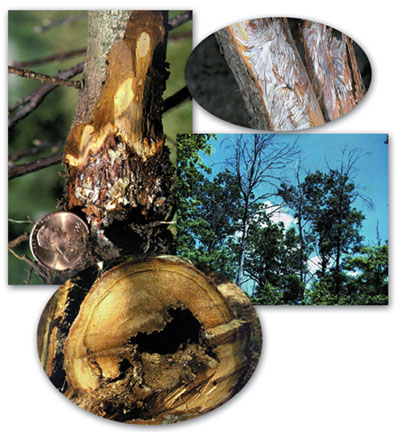 |
Fungi invade the entire tree branch on which they settle. Some are opportunists that eat the trees that start to die. |
Fungi may sometimes cause problems in the formation of fruit and vegetables. The fungus known as Oomycota phytophthora generally invades tomatoes and potatoes, on a large scale that can have very serious effects. The great potato famine between 1845 and 1860 in Ireland was one consequence of this fungus. 95
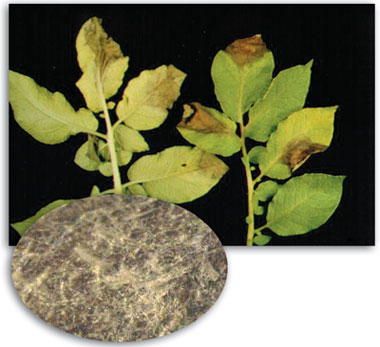 |
The fungus Oomycota phytophthora is a most damaging species that caused the potato famine in Ireland. |
Fungi can also invade the bodies of some animals. Most cause disease, some can even lead to death. Some deliberately kill so as to use their host's body as food. For example, one variety of worms known as nematodes, far smaller than earthworms, fall prey to the extraordinary traps set by fungi. When the fungi that nematodes are nearby they lay sticky traps to stop the worms from getting away. Even the simplest of these traps possesses three sensitive cells that sense the prey in one-tenth of a second. When these cells sense pressure, they contract and close up, catching their prey in the trap. This snare, consisting of fungal cells, forms a network that quickly grows and digests the prey within a few hours. Even if the worms that fall into the trap escape, and even if the spores of the fungus are only very few in number, they are still on the worm's body and sooner or later will grow. Consequently, the worm will die within one hour. 96
The existence of a carnivorous fungus is certainly surprising, yet the really astonishing thing is the fungus's ability to trap its prey. The most important question is how fungi, which are invisible and which we need technology to understand how they live and exist, came by the consciousness that let them set traps. The answer to that question leads any rational person to appreciate the existence of Allah. The way that microscopic living things develop such intelligent methods reveals that Allah has created the universe in perfect harmony.
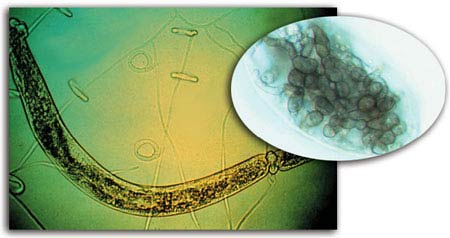 |
A nematode surrounded by fungi. |
Fungal Methods Of Self-Defence
Like bacteria and other microorganisms, fungi take precautions and perform intentional processes they to ensure their own survival. When the temperature approaches the freezing point, these organisms form ice crystals around their bodies thanks to various chemicals. As you have already seen, bacteria and algae seek shelter in the upper layers of the atmosphere when they realize that conditions at ground level are becoming difficult for them, and seemingly decide to move to warmer locations by means of air currents. Once they have assumed the form of an ice crystal, to move up into the clouds with the wind. At an appropriate time and place, they then return to Earth as dormant, but living seeds. Thanks to this efficient method, algae are able to survive and also to spread around easily.
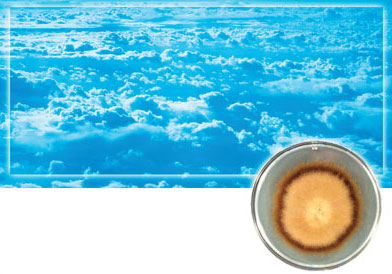 |
When the temperature approaches freezing point fungi seek shelter in the upper reaches of the atmosphere by forming ice crystals around their bodies. They remain there, literally in hibernation, until carried to a warmer location by air currents. |
The way that a microorganism can use the chemicals around it by sensing when the temperature approaches the freezing point is doubtless a most superior attribute, and the method employed is a most practical one. This living thing needs to know in advance that it can be protected inside an ice crystal while in the clouds. It's of course impossible for it to learn this gradually, through trial and error, since this is not a conscious entity that can learn by experimentation, but a microorganism. This again reveals the illogicality at the heart of the theory of evolution and the frustration suffered by Darwinists. No evolutionary mechanism can account for a microorganism choosing to protect itself with such a complex mechanism, which it manages to achieve so easily.
Evolutionists will never be able to account for this, because Allah has created every living thing, every fine detail it possesses, and its every flawless feature. Living entities need not know beforehand the precautionary measures essential to their survival, or to discover them by trial and error, because they are under the control of Allah, Who protects them with His compassion. They do only what He tells them. They obey only Him.
Moulds: Another Variety of Fungus
 |
Moulds are single-celled fungi with a single nucleus. They multiply by dividing, and assume the form of a colony by banding together. Mould cells are generally larger than bacteria's, egg-shaped, and possess most of the organelles found in an animal cell.
Moulds are single-celled fungi with a single nucleus. They multiply by dividing, and assume the form of a colony by banding together. Mould cells are generally larger than bacteria's, egg-shaped, and possess most of the organelles found in an animal cell.
 |
Fruits and vegetables, a great blessing and delight for us, can change their qualities entirely because of microscopic organisms. Moulds can turn a food into a poisonous substance by means of the toxin they release. |
Just as moulds feed on organic wastes around them, they can also feed on other microorganisms. Entomophtorales, a white mould, feeds on amoeba living in moist soil. When it senses an amoeba moving nearby, it seizes it and absorbs its cellular contents, leaving only the membrane behind. 97
However, not all moulds are harmful. They can serve mankind in a wide number of ways, from food production to drug manufacture. Moulds are employed in the manufacture of organic acids, various antibiotics such as penicillin, and some drugs that suppress the immune system, as well as of various antibiotics such as penicillin.
The uses of moulds in this area are of very great importance.
Moulds Are Used in the Manufacture of Certain Drugs
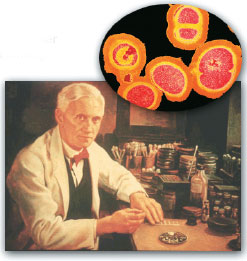 |
The bacterium Staphylococcus and |
The effects of microorganisms on life can assume various forms. A particle of mould we may see on a piece of bread from time to time may actually be exceedingly important and affect a large part of our lives. The use of moulds in medicine is very important in terms of seeing that effect. Certain serious diseases, even fatal ones, have been totally eliminated with drugs developed with the help of these microorganisms.
In 1928, Alexander Fleming placed various species of bacteria in various experimental dishes and observed that moulds had formed in one of the dishes containing the bacterium Staphylococcus. in the layer in which the mould formed, he saw no trace of the bacterium that he'd expected to grow. He discovered that the mould—a species of fungus known as Penicillium notatum—had secreted a substance poisonous to the bacterium and eliminated it. The drug penicillin was produced by purifying this micro-organism's secretions.
Penicillin, the first effective treatment for bacterial infections, arose from the discovery of this mould's ability to kill bacteria. This mould has been protecting against deadly diseases for around a century, and is also used to manufacture a great many other medicines.
Cyclosporine, a drug used to suppress the immune system following organ transplants, is also produced from two species of fungus. Some fungi are employed in drugs to control bleeding, lower blood pressure, and lighten the pain of migraines.
Yeasts That Produce Foodstuffs Through Fermentation
There are around 600 known species of yeasts, single-celled fungi that can be spherical, oval or cylindrical in shape, and are 7 to 17 microns in size. One gram of yeast therefore can contain some 15 million independent cells of yeast.
 |
The bread yeast seen in the pictures above performs fermentation in an oxygen-free environment. The result of this activity is delicious foods. |
Yeasts feed on sugar, and in an oxygen-free environment can produce from it ethyl alcohol and carbon dioxide.
This process, called fermentation, is of considerable economic importance. Yeast is the basic element in the making of various foods, giving bread its texture and flavor by producing tiny bubbles of carbon dioxide in the dough. Yeast is also used in fermenting soya, which produces low-calorie soy sauce. People who consume soy sauce enjoy vital amino acids provided by the combination of yeast and soya beans, so long as they do not take in too many calories. Therefore, yeasts are both nutritional and also serve in the production of useful foods.
Lichens: Fungi and Algae Sharing A Life
Some fungi live symbiotically with algae, producing a new combination is known as a lichen. The fungus obtains food from the photosynthesis carried out by the algae, and thanks to the water and minerals in the fungus, the algae is protected from drying out.
This new living colony of these two microorganisms generally receives minerals from the air and rainwater. But it cannot resist toxins in the air, and so can survive only where there is no pollution. Temperature, on the other hand, has little impact on lichen's survival. Lichens thrive in both tropical regions and in cold areas such as the Arctic and the South Pole.
 |
Lichens, the product of a shared life between fungi and algae. |
Lichens generally live in clean air, and on tree trunks, mountain peaks and bare rocks. As the fungus obtains food thanks to photosynthesis, carried out by algae, algae obtain minerals thanks to the way fungus breaks substances down. In addition, they also thus obtain a safe shelter. The lichens use their fungi to slowly break down the rock surface and lead to its being eroded by wind and rain. Some lichens are strong enough to break apart the strongest rocks.98 Thanks to this, soil forms as the rock breaks down. No other living thing can perform such a powerful process.
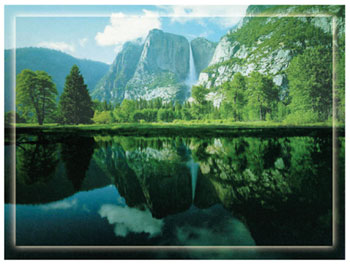 |
Lichens generally live in clean air, on tree trunks, mountain peaks and bare rocks. As the fungus obtains food thanks to photosynesis, carried out by the algae , algae obtain minerals thanks to the fungus's property of breaking substances down. In addition, they also obtain a safe shelter. |
You would have to expend enormous effort to break a hard rock into minute particles. And after having broken the rock down into the smallest particles, you would have to subject it to various chemical processes to obtain its component minerals. Only in this may might you be able to achieve a part of your objective. Yet microscopic organisms quietly perform this laborious, energy-consuming process without the need for pick or shovel or special laboratory conditions. There is an important contrast here; on the one hand is an intelligent, conscious human being, capable of making plans and mobilizing all kinds of resources. On the other hand, lichen is a microscopic living entity, unaware even of their own existence, with no other objective than feeding and reproducing. The way that such minute unaware entities display apparent volition deals a major blow to the theory of evolution and its claims. This microscopic organism to which they previously attached no importance is capable of undermining their theory in a way they never expected.
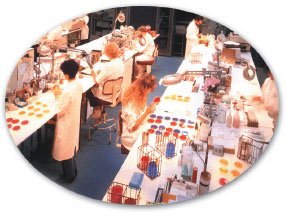 |
Thanks to the algae, lichens contain various pigments. One of these, orchil, is used to dye wool, and litmus is used in laboratories as an acid base inhibitor. |
These organisms possess other features too. The algae that some lichens possess also contain colored pigments. One of them, orchil, is used to dye wools. Another, litmus, is used as an acid base (pH) inhibitor in chemical laboratories.
We are faced by a living thing both of whose members perform highly conscious activities and that have highly detailed features. A lichen carries out very conscious processes and can produce its own food, while breaking down rock to make simple organic compounds that other living things can use. The reproduction or spread of a lichen also displays the same conscious planning. Under difficult conditions or when they decide to multiply, lichens bud off a component known as the soredia, which bears the parts and features of both the algae and fungus. In order to multiply, it settles in a suitable place and produces a new lichen. If the lichen's algae die, or if the fungal member of the lichen wishes to change its partner for any reason, then it produces fungus spores that are carried by the wind and find new algae for themselves in new places where they have never been, under conditions of which they are unaware. 99
How and why these organisms combine to create a new living entity, and why they originally chose to live together, are difficult to comprehend. These two microorganisms can survive on their own, yet for some reason have decided to live in partnership. If all living species underwent developmental changes according to a process of evolution, then this shared life could have emerged only as the result of a very great need. Yet there is no such urgency here; algae and fungi are not forced to depend on each other. The lichens formed by their coming together are actually completely separate structures. The two species have joined forces to break down rocks and form soil, even though they themselves will obtain no benefit. Like all other living things, they have submitted to Allah and act according to His inspiration.
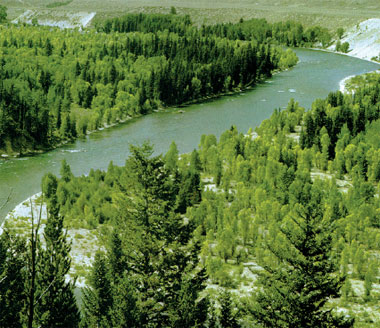 |
He Who created and moulded; He Who determined and guided; He Who brings forth green pasture (Surat al-A'la; 2-4) |
In the Qur'an, Allah reveals that these entities contain important knowledge for those able to use their reason:
It is He Who originated Creation and then regenerates it. That is very easy for Him. His is the most exalted designation in the heavens and the Earth. He is the Almighty, the All-Wise. He has made an example for you from among yourselves. Are any of the slaves you own partners with you in what We have provided for you so that you are equal in respect of it, you fearing them the same as one another? In that way We make Our Signs clear for people who use their intellect. ( Surat ar-Rum, 27-28)
Footnotes
82- L.M.Prescott- J.P.Harley- D.A.Klein, Microbiology, McGrawHill, International, 1999, sf. 524
83- Guy Murchie, The Seven Mysteries of Life, Houghton Mifflin Company, Boston, 1978, sf. 72
84- http://www.uwc.ca/pearson/fungi/fahpbio.htm
85- Yvonne Baskin, Trouble at Timberline, Natural History, Kasım 1998, sf. 53
86- Guy Murchie, The Seven Mysteries of Life, Houghton Mifflin Company, Boston, 1978, sf. 72
87- http://www.geocities.com/jw31645/fungi-n.html
88- E.P.Solomon, L.R.Berg, D.W.Martin, C.Villee, Biology, Saunders College Publishing, USA, 1993, sf.548
89- http://www.cfe.cornell.edu/compost/microorg.html – Cornell Composting – Science and Engineering / Compost Microorganisms by Nancy Trautman and Elania Olynciw
90- E.P.Solomon, L.R.Berg, D.W.Martin, C.Villee, Biology, Saunders College Publishing, USA, 1993, sf.548
91- Yvonne Baskin, Trouble at Timberline, Natural History, Kasım 1998, sf. 53
92- E.P.Solomon, L.R.Berg, D.W.Martin, C.Villee, Biology, Saunders College Publishing, USA, 1993, sf.560
93- Yvonne Baskin, Trouble at Timberline, Natural History, Kasım 1998, sf. 50
94- Yvonne Baskin, Trouble at Timberline, Natural History, Kasım 1998, sf. 53
95- http://www.geocities.com/jw31645/fungi-n.html – Mr. William's Biology
96- Guy Murchie, The Seven Mysteries of Life, Houghton Mifflin Company, Boston, 1978, sf. 97
97- http://www.ogm.gov.tr/sites1/ETOBUR.htm
98- E.P.Solomon, L.R.Berg, D.W.Martin, C.Villee, Biology, Saunders College Publishing, USA, 1993, sf.556-558
99- E.P.Solomon, L.R.Berg, D.W.Martin, C.Villee, Biology, Saunders College Publishing, USA, 1993, sf.556-558
